Question
Business Ethics: Case: The Ethics of Marketing Nestls Infant Formula article written by Jame E. Post. Please answer the following questions thoroughly: 1)Unlike Johnson &
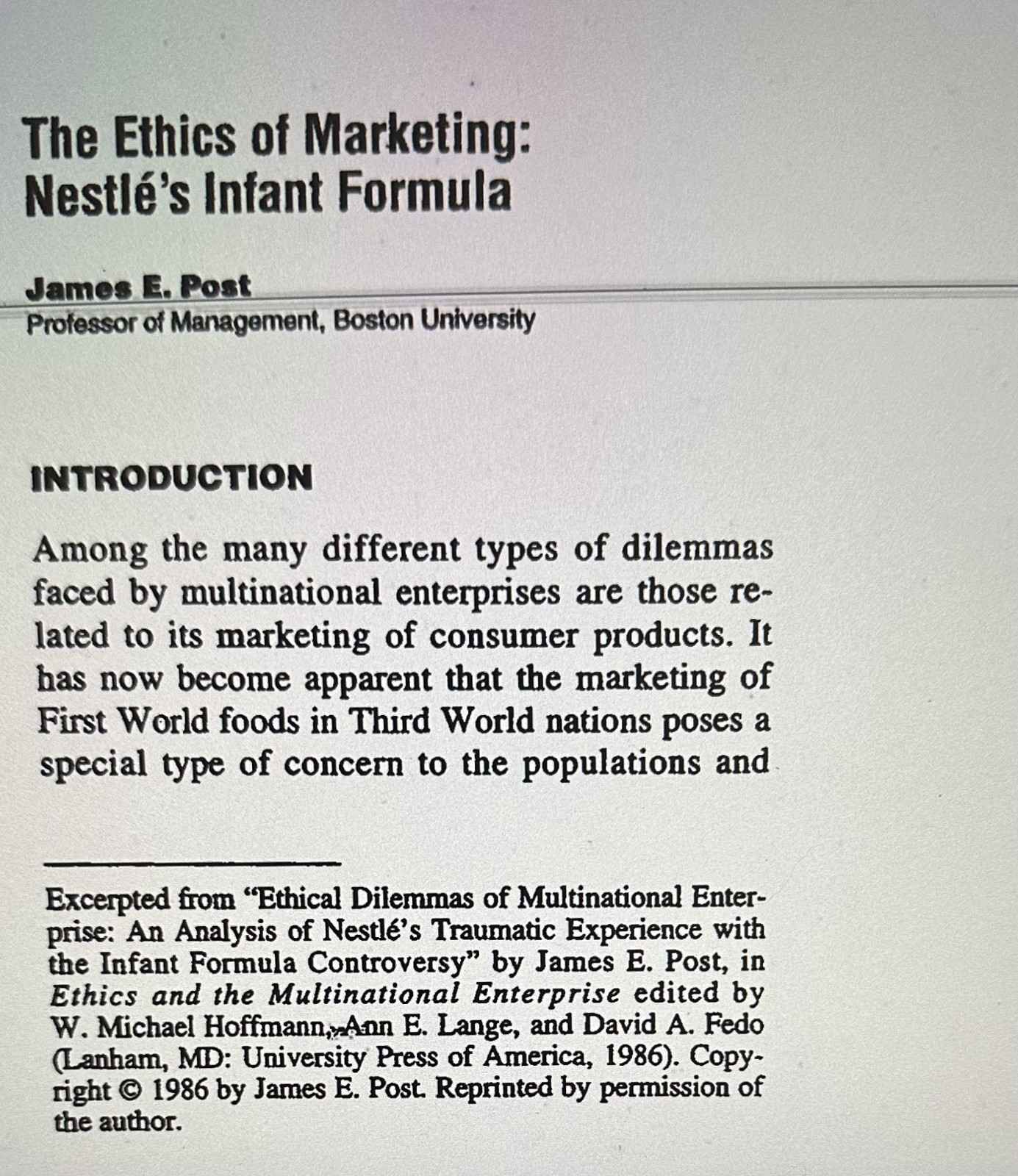

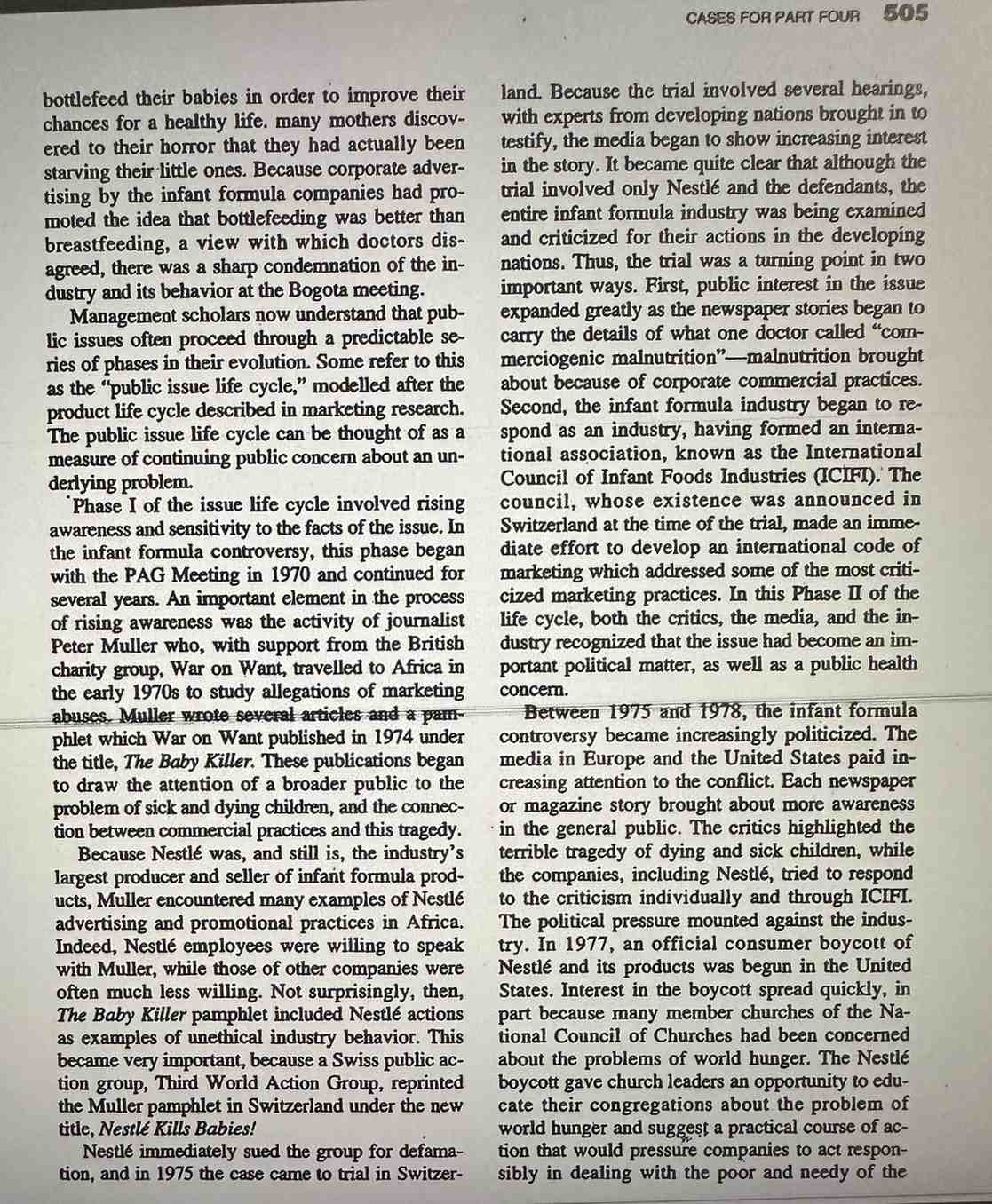
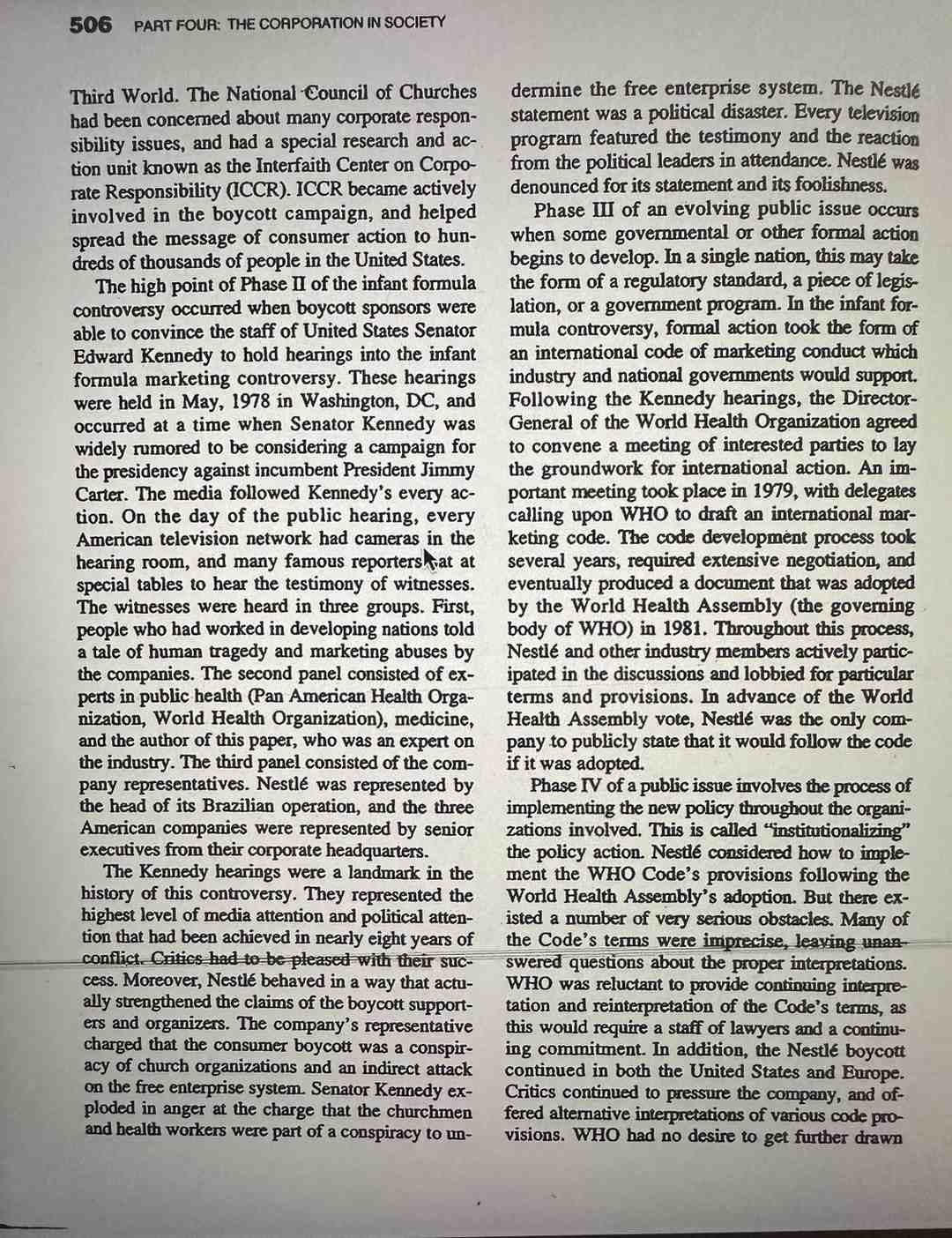
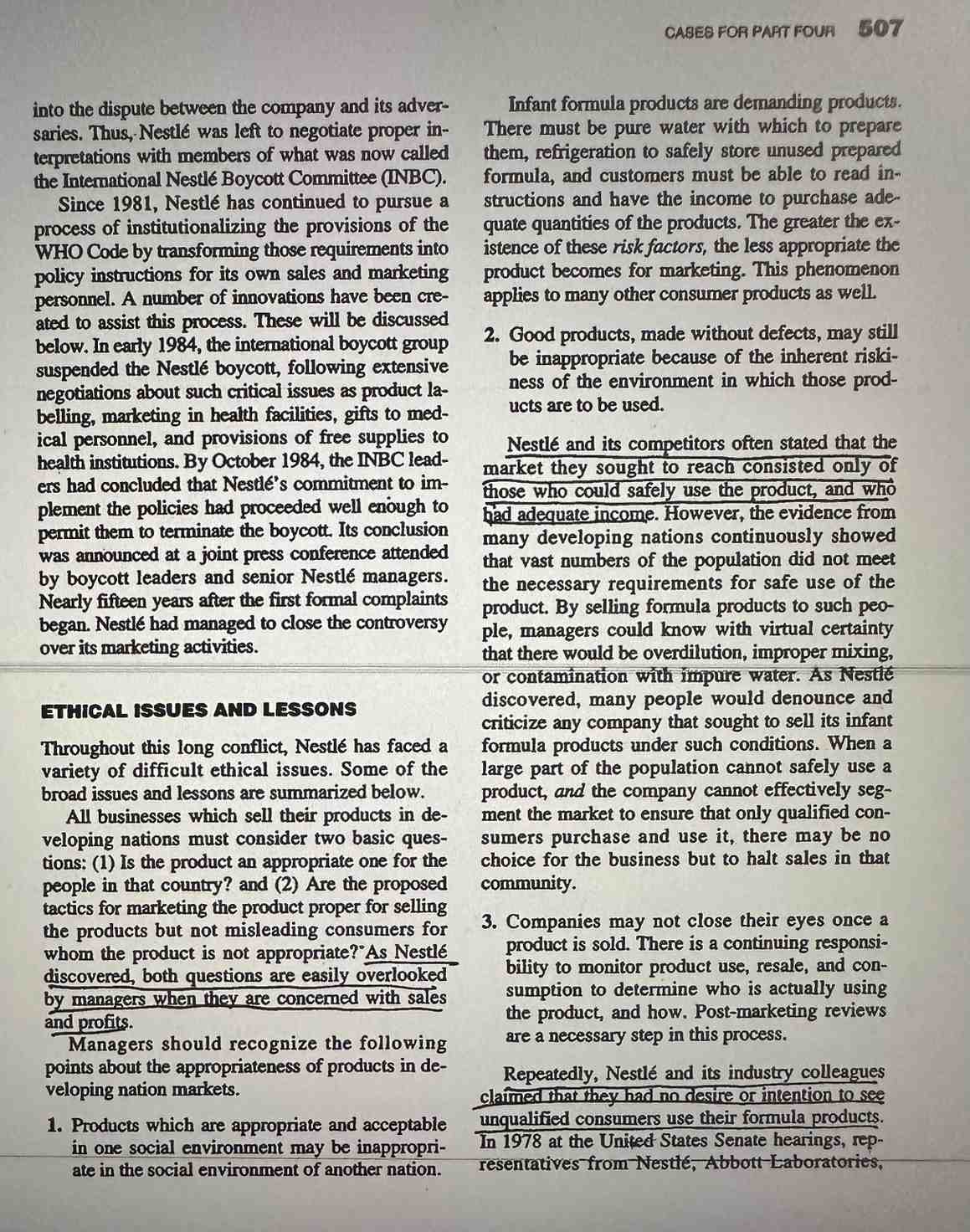
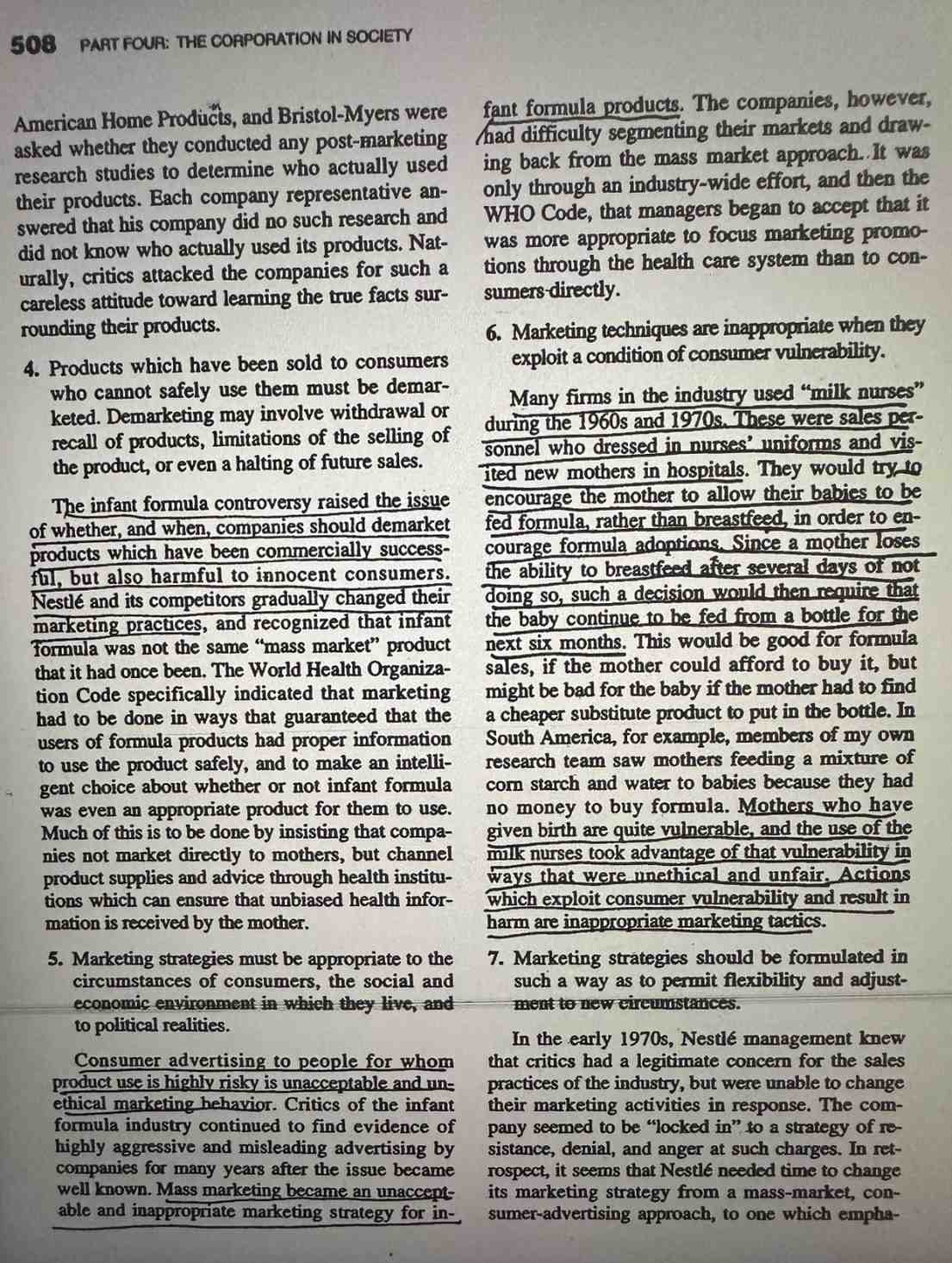
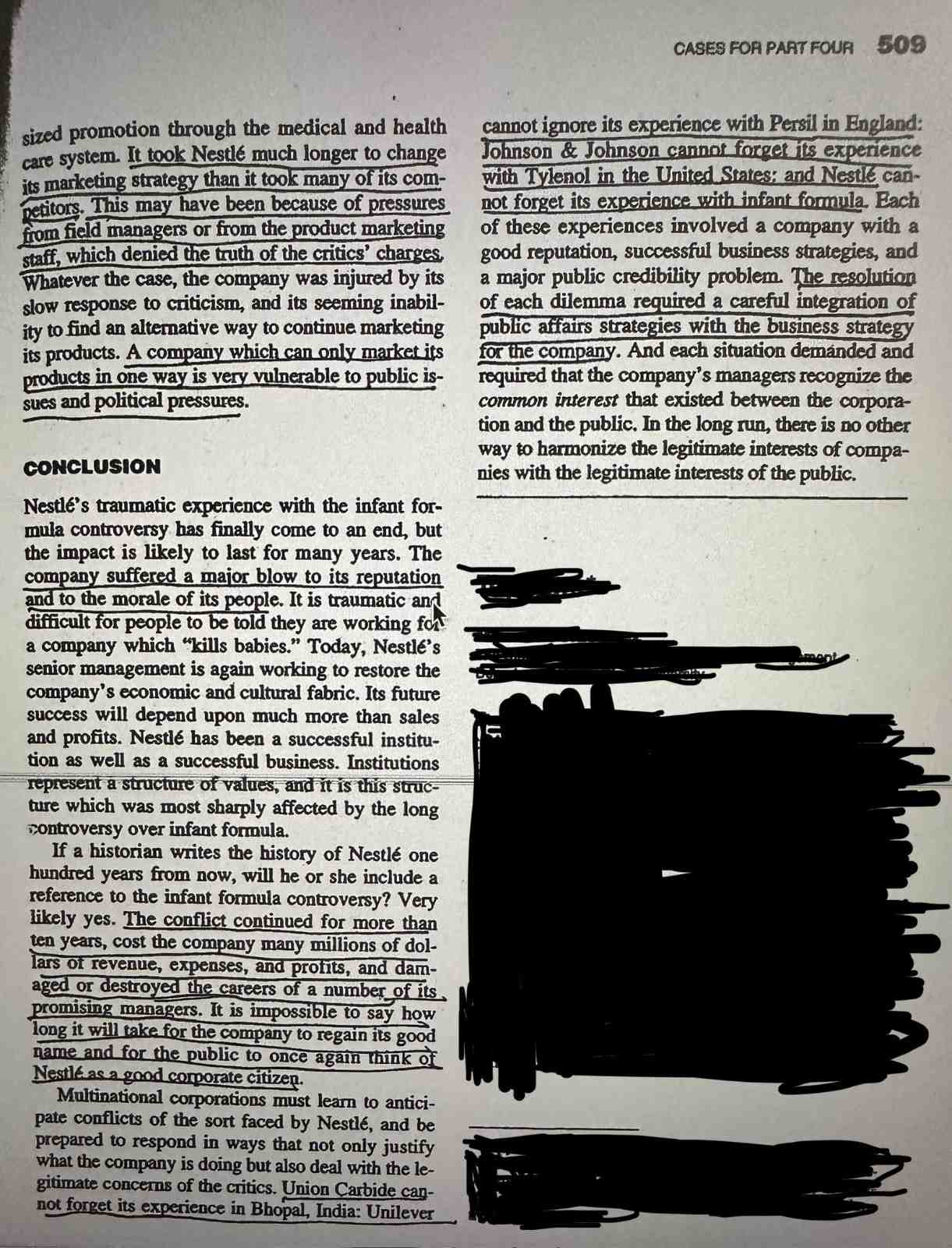
Business Ethics:
Case: The Ethics of Marketing Nestls Infant Formula article written by Jame E. Post.
Please answer the following questions thoroughly:
1)Unlike Johnson & Johnson, Nestls decided to stay with their product sales and marketing strategy. What affects did this decision have on Nestls? On Nestls stakeholders?
2)Did Nestls display the tenet of Due Care Theory? If so, how? If not, what ethical philosophy did they use which would characterize Nestls actions?
3)Should there be global ethical standards given the different cultures, beliefs, values, and economic conditions? If so, how would they be enforced?
4)What is the role and value of social action in forcing change on a multinational corporation (MNC)?
5)Given the psychological effects of advertising on consumer beliefs and behavior, what can be learned from this event and applied to industry in general?
The Ethics of Marketing: Nestl's Infant Formula James E. Post Professor of Management, Boston University INTRODUCTION Among the many different types of dilemmas faced by multinational enterprises are those related to its marketing of consumer products. It has now become apparent that the marketing of First World foods in Third World nations poses a special type of concern to the populations and Excerpted from "Ethical Dilemmas of Multinational Enterprise: An Analysis of Nestl's Traumatic Experience with the Infant Formula Controversy" by James E. Post, in Ethics and the Multinational Enterprise edited by W. Michael Hoffmann, rann E. Lange, and David A. Fedo (Lanham, MD: University Press of America, 1986). Copyright 1986 by James E. Post. Reprinted by permission of the author. Third World. The National Council of Churches had been concerned about many corporate responsibility issues, and had a special research and action unit known as the Interfaith Center on Corporate Responsibility (ICCR). ICCR became actively involved in the boycott campaign, and helped spread the message of consumer action to hundreds of thousands of people in the United States. The high point of Phase II of the infant formula controversy occurred when boycott sponsors were able to convince the staff of United States Senator Edward Kennedy to hold hearings into the infant formula marketing controversy. These hearings were held in May, 1978 in Washington, DC, and occurred at a time when Senator Kennedy was widely rumored to be considering a campaign for the presidency against incumbent President Jimmy Carter. The media followed Kennedy's every action. On the day of the public hearing, every American television network had cameras in the hearing room, and many famous reporters hat at special tables to hear the testimony of witnesses. The witnesses were heard in three groups. First, people who had worked in developing nations told a tale of human tragedy and marketing abuses by the companies. The second panel consisted of experts in public health (Pan American Health Organization, World Health Organization), medicine, and the author of this paper, who was an expert on the industry. The third panel consisted of the company representatives. Nestle was represented by the head of its Brazilian operation, and the three American companies were represented by senior executives from their corporate headquarters. The Kennedy hearings were a landmark in the history of this controversy. They represented the highest level of media attention and political attention that had been achieved in nearly eight years of conflict Critics had to be pleased with their success. Moreover, Nestl behaved in a way that actually strengthened the claims of the boycott supporters and organizers. The company's representative charged that the consumer boycott was a conspiracy of church organizations and an indirect attack on the free enterprise system. Senator Kennedy exploded in anger at the charge that the churchmen and health workers were part of a conspiracy to un- dermine the free enterprise system. The Nestle statement was a political disaster. Every television program featured the testimony and the reaction from the political leaders in attendance. Nestle was denounced for its statement and its foolishness. Phase III of an evolving public issue occurs when some governmental or other formal action begins to develop. In a single nation, this may take the form of a regulatory standard, a piece of legislation, or a government program. In the infant formula controversy, formal action took the form of an international code of marketing conduct which industry and national governments would support. Following the Kennedy hearings, the DirectorGeneral of the World Health Organization agreed to convene a meeting of interested parties to lay the groundwork for international action. An important meeting took place in 1979, with delegates calling upon WHO to draft an international marketing code. The code development process took several years, required extensive negotiation, and eventually produced a document that was adopted by the World Health Assembly (the governing body of WHO) in 1981. Throughout this process, Nestle and other industry members actively participated in the discussions and lobbied for particular terms and provisions. In advance of the World Health Assembly vote, Nestle was the only company to publicly state that it would follow the code if it was adopted. Phase IV of a public issue involves the process of implementing the new policy throughout the organizations involved. This is called "institutionalizing" the policy action. Nestle considered how to implement the WHO Code's provisions following the World Health Assembly's adoption. But there existed a number of very serious obstacles. Many of the Code's terms were imprecise, leaxing unanswered questions about the proper interpretations. WHO was reluctant to provide continaing interpretation and reinterpretation of the Code's terms, as this would require a staff of lawyers and a continuing commitment. In addition, the Nestle boycott continued in both the United States and Europe. Critics continued to pressure the company, and offered alternative interpretations of various code provisions. WHO had no desire to get further drawn 504 PART FOUR: THE CORPORATION IN SOCIETY governments of host hiations, and to the would-be marketers themselves. While there are a number of products that one can cite as illustrative of the generic issue, none has so sharply and clearly defined it as the controversy surrounding the marketing and promotion of infant formula in the developing world. My perspective on the infant formula controversy, industry, and on. Nestle in particular, is derived from more than a decade of research. In addition to field research on infant formula marketing in Latin America, Africa, and Southem Asia. I have served as a consultant to the World Health Organization (WHO) in the development of the international marketing code, and testified at congressional and United States Senate hearings on these issues. Most recently, it has included about 18 months of service on the Nestle Infant Formula Audit Commission, which was created to monitor the company's compliance with marketing policies that were drafted for the purpose of implementing the WHO Code. Rest assured, this is no apologia for Nestle. I know that some of their managers disagree with my interpretation of the evidence. That troubles me little, for I cannot think of an ethical dilemma that does not breed some disagreement among caring participants. Were it otherwise, I doubt it could be called a dilemma. Among the various types of ethical dilemmas confronting the managers of multinational enterprises (MNEs) are those tied to the introduction of products developed and used in one social environment into a significantly different environment. I prefer to term this the introduction of First World Products in Third Word Markets. The infant formula situation involves a product which is not defective in itself. This distinguishes it from such cases as the dumping of products which are unsafe or deemed unacceptable for sale in the United States, but are accepted for sale in another nation (e.g., Tris-treated sleepwear). Infant formula is also not harmful to the consumer (user) when used properly under appropriate conditions. This distinguishes it from products such as tobacco, which are, in the view of most health professionals, per se dangerous to all users. Infant formula is the definitive example, however, of a First World product which is safe when used properly, but which is demanding. That is, when risk conditions are present, it can be-and is - potentially harmful to users. The fundamental ethical dilemma for MNE managers, then, is whether such a prochuct can be marketed when it cannot be guaranteed, or reasonably expected, that it will be used by people who meet the minimum conditions necessary for safe use. EVOLUTION OF A PUBLIC ISSUE The criticism of the infant formula manufacturers for their aggressive marketing behavior in developing nations became a serious issue in 1970. Prior to that time, individual physicians and bealth workers had criticized promotional practices, but there was nothing to suggest an organized campaign of criticism. In 1970, however, the ProteinCalorie Advisory Group (PAG) of the United Nations held a meeting in Bogota to discuss the problem of infant malnutrition and disease in developing nations. Participants pointed a finger of blame at the industry, charging that it pushed its products to mothers, many of whom lived in circumstances that made the use of such products a highly risky adventure. First, infant formula must be sold in powdered form in tropical environments, requiring that the mother mix the powder with locally available water. When water supplies are of poor quality, as so often is the case in the developing nations, infants are exposed to disease. Second, since the product must be mixed, preparation instructions are important, and mothers must be able to read. Unfortunately, the rate of illiteracy is very high in many developing nations. Thindly, since infant formulas are relatively expensive to purchase, there is a temptation to overdilute the powder with water. This effort to "stretch" its uses enables the mother to go a few extra days without buying a new supply. Unfortunately, overdihuted formula preparations provide very poor nutrition to the baby. Thus mothers who came to the health clinics with malnourished babies often reported that a five day supply of formula had been stretched to ten days or more. Having decided to American Home Prodictsts, and Bristol-Myers were asked whether they conducted any post-marketing research studies to determine who actually used their products. Each company representative answered that his company did no such research and did not know who actually used its products. Naturally, critics attacked the companies for such a careless attitude toward learning the true facts surrounding their products. 4. Products which have been sold to consumers who cannot safely use them must be demarketed. Demarketing may involve withdrawal or recall of products, limitations of the selling of the product, or even a halting of future sales. The infant formula controversy raised the issue of whether, and when, companies should demarket products which have been commercially successful, but also harmful to innocent consumers. Nestle and its competitors gradually changed their marketing practices, and recognized that infant formula was not the same "mass market" product that it had once been. The World Health Organization Code specifically indicated that marketing had to be done in ways that guaranteed that the users of formula products had proper information to use the product safely, and to make an intelligent choice about whether or not infant formula was even an appropriate product for them to use. Much of this is to be done by insisting that companies not market directly to mothers, but channel product supplies and advice through bealth institutions which can ensure that unbiased health information is received by the mother. 5. Marketing strategies must be appropriate to the circumstances of consumers, the social and economic environment in which they live, and to political realities. Consumer advertising to people for whom product use is highly risky is unacceptable and unethical marketing hehavior. Critics of the infant formula industry continued to find evidence of highly aggressive and misleading advertising by companies for many years after the issue became well known. Mass marketing became an unacceptable and inappropriate marketing strategy for in- fant formula products. The companies, however, had difficulty segmenting their markets and drawing back from the mass market approach. It was only through an industry-wide effort, and then the WHO Code, that managers began to accept that it was more appropriate to focus marketing promotions through the health care system than to consumers-directly. 6. Marketing techniques are inappropriate when they exploit a condition of consumer vulnerability. Many firms in the industry used "milk nurses" during the 1960 s and 1970s. These were sales personnel who dressed in nurses' uniforms and visited new mothers in hospitals. They would try to encourage the mother to allow their babies to be fed formula, rather than breastfeed, in order to encourage formula adoptions. Since a mother loses the ability to breastfeed after several days of not doing so, such a decision would then requice that the baby continue to be fed from a bottle for the next six months. This would be good for formula sales, if the mother could afford to buy it, but might be bad for the baby if the mother had to find a cheaper substitute product to put in the bottle. In South America, for example, members of my own research team saw mothers feeding a mixture of corn starch and water to babies because they had no money to buy formula. Mothers who have given birth are quite vulnerable, and the use of the milk nurses took advantage of that vulnerability in ways that were unethical and unfair. Actions which exploit consumer vulnerability and result in harm are inappropriate marketing tactics. 7. Marketing strategies should be formulated in such a way as to permit flexibility and adjustment to new eircumistances. In the early 1970s, Nestle management knew that critics had a legitimate concern for the sales practices of the industry, but were unable to change their marketing activities in response. The company seemed to be "locked in" to a strategy of rosistance, denial, and anger at such charges. In retrospect, it seems that Nestle needed time to change its marketing strategy from a mass-market, consumer-advertising approach, to one which empha- bottlefeed their babies in order to improve their chances for a healthy life. many mothers discovered to their horror that they had actually been starving their little ones. Because corporate advertising by the infant formula companies had promoted the idea that bottlefeeding was better than breastfeeding, a view with which doctors disagreed, there was a sharp condemnation of the industry and its behavior at the Bogota meeting. Management scholars now understand that public issues often proceed through a predictable series of phases in their evolution. Some refer to this as the "public issue life cycle," modelled after the product life cycle described in marketing research. The public issue life cycle can be thought of as a measure of continuing public concern about an underlying problem. Phase I of the issue life cycle involved rising awareness and sensitivity to the facts of the issue. In the infant formula controversy, this phase began with the PAG Meeting in 1970 and continued for several years. An important element in the process of rising awareness was the activity of journalist Peter Muller who, with support from the British charity group, War on Want, travelled to Africa in the early 1970 s to study allegations of marketing abuses. Muller wrote several articles and a painphlet which War on Want published in 1974 under the title, The Baby Killer. These publications began to draw the attention of a broader public to the problem of sick and dying children, and the connection between commencial practices and this tragedy. Because Nestle was, and still is, the industry's largest producer and seller of infant formula products, Muller encountered many examples of Nestle advertising and promotional practices in Africa. Indeed, Nestle employees were willing to speak with Muller, while those of other companies were often much less willing. Not surprisingly, then, The Baby Killer pamphlet included Nestl actions as examples of unethical industry behavior. This became very important, because a Swiss public action group, Third World Action Group, reprinted the Muller pamphlet in Switzerland under the new title, Nestle Kills Babies! Nestle immediately sued the group for defamation, and in 1975 the case came to trial in Switzer- land. Because the trial involved several hearings, with experts from developing nations brought in to testify, the media began to show increasing interest in the story. It became quite clear that although the trial involved only Nestle and the defendants, the entire infant formula industry was being examined and criticized for their actions in the developing nations. Thus, the trial was a turning point in two important ways. Firsh, public interest in the issue expanded greatly as the newspaper stories began to carry the details of what one doctor called "commerciogenic malnutrition" - malnutrition brought about because of corporate commercial practices. Second, the infant formula industry began to respond as an industry, having formed an international association, known as the International Council of Infant Foods Industries (ICIFI). The council, whose existence was announced in Switzerland at the time of the trial, made an immediate effort to develop an international code of marketing which addressed some of the most criticized marketing practices. In this Phase II of the life cycle, both the critics, the media, and the industry recognized that the issue had become an important political matter, as well as a public health concem. Between 1975 and 1978 , the infant formula controversy became increasingly politicized. The media in Europe and the United States paid increasing attention to the conflict. Each newspaper or magazine story brought about more awareness in the general public. The critics highlighted the terrible tragedy of dying and sick children, while the companies, including Nestle, tried to respond to the criticism individually and through ICIFI. The political pressure mounted against the industry. In 1977, an official consumer boycott of Nestle and its products was begun in the United States. Interest in the boycott spread quickly, in part because many member churches of the Na tional Council of Churches had been concerned about the problems of world hunger. The Nestle boycott gave church leaders an opportunity to educate their congregations about the problem of world hunger and suggest a practical course of action that would pressure companies to act responsibly in dealing with the poor and needy of the sized promotion through the medical and health care system. It took Nestl much longer to change its marketing strategy than it took many of its competitors. This may have been because of pressures from field managers or from the product marketing staff, which denied the truth of the critics' charges, Whatever the case, the company was injured by its slow response to criticism, and its seeming inability to find an alternative way to continue marketing its products. A company which can only market its products in one way is very vulnerable to public issues and political pressures. CONCLUSION Nestle's traumatic experience with the infant formula controversy has finally come to an end, but the impact is likely to last for many years. The company suffered a major blow to its reputation and to the morale of its people. It is traumatic and difficult for people to be told they are working foh a company which "kills babies." Today, Nestle's senior management is again working to restore the company's economic and cultural fabric. Its future success will depend upon much more than sales and profits. Nestl has been a successful institution as well as a successful business. Institutions represent a structure of values, and it is this structure which was most sharply affected by the long Dontroversy over infant formula. If a historian writes the history of Nestle one hundred years from now, will he or she include a reference to the infant formula controversy? Very likely yes. The conflict continued for more than ten years, cost the company many millions of dollars of revenue, expenses, and protits, and damaged or destroyed the careers of a number of its promising managers. It is impossible to say how long it will take for the company to regain its good name and for the public to once again tinnk of Nestlas a good comporate citizen. Multinational corporations must learn to anticipate conflicts of the sort faced by Nestle, and be prepared to respond in ways that not only justify what the company is doing but also deal with the legitimate concerns of the critics. Union Carbide cannot forget its experience in Bhopal, India: Unilever cannot ignore its experience with Persil in England: Johnson \& Johnson cannot forget its experience with Tylenol in the United Shates: and Nestle cannot forget its experience with infant formula. Bach of these experiences involved a company with a good reputation, successful business strategies, and a major public credibility problem. The resolution of each dilemma required a careful integration of public affairs strategies with the business strategy for the company. And each situation demanded and required that the company's managers recognize the common interest that existed between the corporation and the public. In the long run, there is no other way to harmonize the legitimate interests of companies with the legitimate interests of the public. into the dispute between the company and its adversaries. Thus, Nestle was left to negotiate proper interpretations with members of what was now called the Intemational Nestl Boycott Committee (INBC). Since 1981, Nestle has continued to pursue a process of institutionalizing the provisions of the WHO Code by transforming those requirements into policy instructions for its own sales and marketing personnel. A number of innovations have been created to assist this process. These will be discussed below. In early 1984, the international boycott group suspended the Nestle boycott, following extensive negotiations about such critical issues as product labelling, marketing in health facilities, gifts to medical personnel, and provisions of free supplies to health institutions. By October 1984, the INBC leaders had concluded that Nestle's commitment to implement the policies had proceeded well enough to permit them to terminate the boycott. Its conclusion was announced at a joint press conference attended by boycott leaders and senior Nestl managers. Nearly fifteen years after the first formal complaints began. Nestle had managed to close the controversy over its marketing activities. ETHICAL ISSUES AND LESSONS Throughout this long conflict, Nestle has faced a variety of difficult ethical issues. Some of the broad issues and lessons are summarized below. All businesses which sell their products in developing nations must consider two basic questions: (1) Is the product an appropriate one for the people in that country? and (2) Are the proposed tactics for marketing the product proper for selling the products but not misleading consumers for whom the product is not appropriate?"As Nestle discovered, both questions are easily overlooked by managers when they are concerned with sales and profits. Managers should recognize the following points about the appropriateness of products in developing nation markets. 1. Products which are appropriate and acceptable in one social environment may be inappropriate in the social environment of another nation. Infant formula products are dernanding products. There must be pure water with which to prepare them, refrigeration to safely store unused prepared formula, and customers must be able to read instructions and have the income to purchase adequate quantities of the products. The greater the existence of these risk factors, the less appropriate the product becomes for marketing. This phenomenon applies to many other consumer products as well. 2. Good products, made without defects, may still be inappropriate because of the inherent riskiness of the environment in which those products are to be used. Nestle and its competitors often stated that the market they sought to reach consisted only of those who could safely use the product, and who had adequate income. However, the evidence from many developing nations continuously showed that vast numbers of the population did not meet the necessary requirements for safe use of the product. By selling formula products to such people, managers could know with virtual certainty that there would be overdilution, improper mixing, or contamination with impure water. As Nestie discovered, many people would denounce and criticize any company that sought to sell its infant formula products under such conditions. When a large part of the population cannot safely use a product, and the company cannot effectively segment the market to ensure that only qualified consumers purchase and use it, there may be no choice for the business but to halt sales in that community. 3. Companies may not close their eyes once a product is sold. There is a continuing responsibility to monitor product use, resale, and consumption to determine who is actually using the product, and how. Post-marketing reviews are a necessary step in this process. Repeatedly, Nestl and its industry colleagues claimed that hey had no desire or intention te see unqualified consumers use their formula products. In 1978 at the United States Senate hearings, representatives from-Nestie. Abbott-LaboratoriesStep by Step Solution
There are 3 Steps involved in it
Step: 1

Get Instant Access to Expert-Tailored Solutions
See step-by-step solutions with expert insights and AI powered tools for academic success
Step: 2

Step: 3

Ace Your Homework with AI
Get the answers you need in no time with our AI-driven, step-by-step assistance
Get Started


